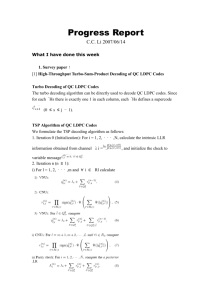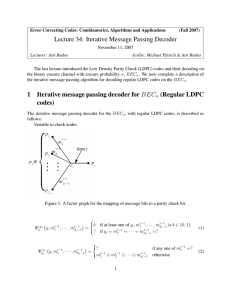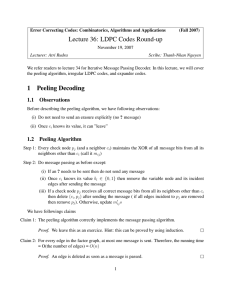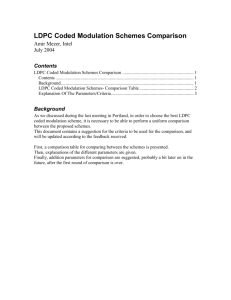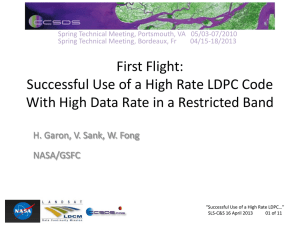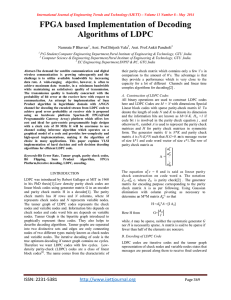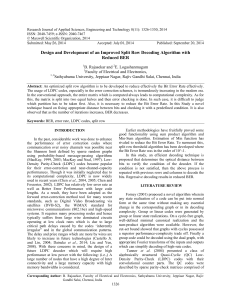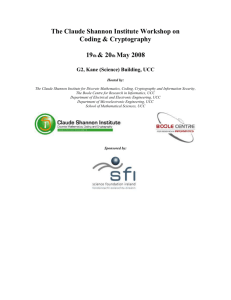Document 14098107
advertisement
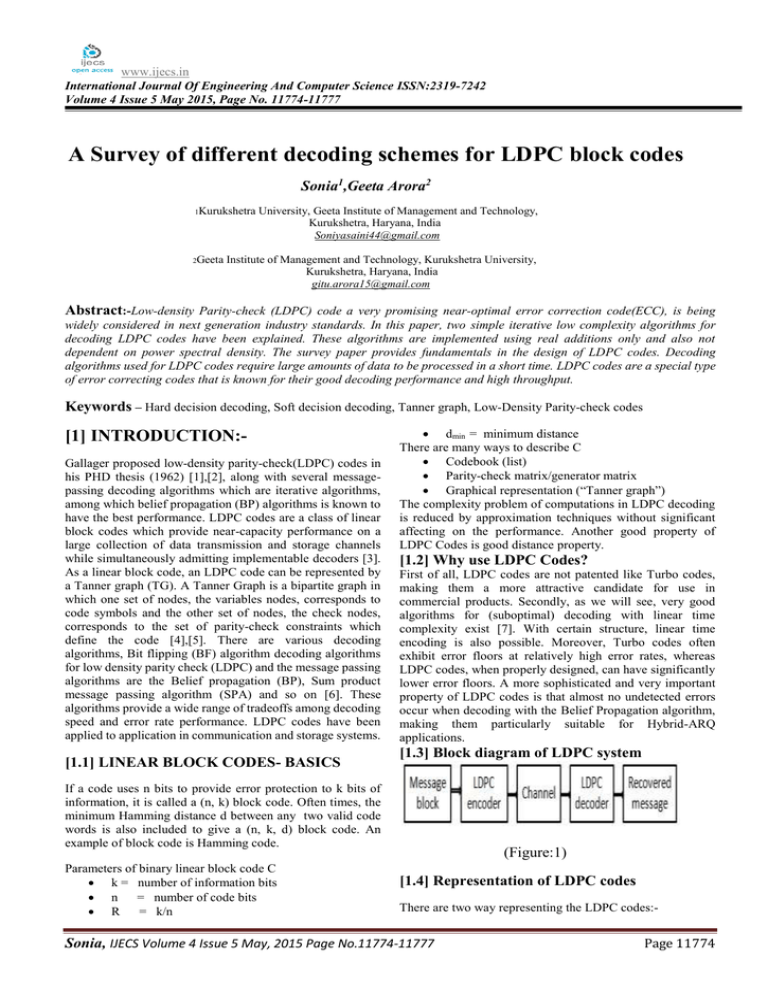
www.ijecs.in International Journal Of Engineering And Computer Science ISSN:2319-7242 Volume 4 Issue 5 May 2015, Page No. 11774-11777 A Survey of different decoding schemes for LDPC block codes Sonia1,Geeta Arora2 1Kurukshetra 2Geeta University, Geeta Institute of Management and Technology, Kurukshetra, Haryana, India Soniyasaini44@gmail.com Institute of Management and Technology, Kurukshetra University, Kurukshetra, Haryana, India gitu.arora15@gmail.com Abstract:-Low-density Parity-check (LDPC) code a very promising near-optimal error correction code(ECC), is being widely considered in next generation industry standards. In this paper, two simple iterative low complexity algorithms for decoding LDPC codes have been explained. These algorithms are implemented using real additions only and also not dependent on power spectral density. The survey paper provides fundamentals in the design of LDPC codes. Decoding algorithms used for LDPC codes require large amounts of data to be processed in a short time. LDPC codes are a special type of error correcting codes that is known for their good decoding performance and high throughput. Keywords – Hard decision decoding, Soft decision decoding, Tanner graph, Low-Density Parity-check codes [1] INTRODUCTION:Gallager proposed low-density parity-check(LDPC) codes in his PHD thesis (1962) [1],[2], along with several messagepassing decoding algorithms which are iterative algorithms, among which belief propagation (BP) algorithms is known to have the best performance. LDPC codes are a class of linear block codes which provide near-capacity performance on a large collection of data transmission and storage channels while simultaneously admitting implementable decoders [3]. As a linear block code, an LDPC code can be represented by a Tanner graph (TG). A Tanner Graph is a bipartite graph in which one set of nodes, the variables nodes, corresponds to code symbols and the other set of nodes, the check nodes, corresponds to the set of parity-check constraints which define the code [4],[5]. There are various decoding algorithms, Bit flipping (BF) algorithm decoding algorithms for low density parity check (LDPC) and the message passing algorithms are the Belief propagation (BP), Sum product message passing algorithm (SPA) and so on [6]. These algorithms provide a wide range of tradeoffs among decoding speed and error rate performance. LDPC codes have been applied to application in communication and storage systems. [1.1] LINEAR BLOCK CODES- BASICS dmin = minimum distance There are many ways to describe C Codebook (list) Parity-check matrix/generator matrix Graphical representation (“Tanner graph”) The complexity problem of computations in LDPC decoding is reduced by approximation techniques without significant affecting on the performance. Another good property of LDPC Codes is good distance property. [1.2] Why use LDPC Codes? First of all, LDPC codes are not patented like Turbo codes, making them a more attractive candidate for use in commercial products. Secondly, as we will see, very good algorithms for (suboptimal) decoding with linear time complexity exist [7]. With certain structure, linear time encoding is also possible. Moreover, Turbo codes often exhibit error floors at relatively high error rates, whereas LDPC codes, when properly designed, can have significantly lower error floors. A more sophisticated and very important property of LDPC codes is that almost no undetected errors occur when decoding with the Belief Propagation algorithm, making them particularly suitable for Hybrid-ARQ applications. [1.3] Block diagram of LDPC system If a code uses n bits to provide error protection to k bits of information, it is called a (n, k) block code. Often times, the minimum Hamming distance d between any two valid code words is also included to give a (n, k, d) block code. An example of block code is Hamming code. Parameters of binary linear block code C k = number of information bits n = number of code bits R = k/n (Figure:1) [1.4] Representation of LDPC codes There are two way representing the LDPC codes:- Sonia, IJECS Volume 4 Issue 5 May, 2015 Page No.11774-11777 Page 11774 • Matrix representation • Graphical representation Any linear code has a bipartite graph [8] and a paritycheck matrix representation. An LDPC code is defined as the null space of an M × N sparse parity check matrix. It can be represented by a bipartite graph, between M check nodes in one set and N variable in the other set. An LDPC code can be decoded by the message-passing decoding algorithm [9]. The matrix below is a parity check matrix with dimension n x m for a (10, 5) code [6]. It has been defined two numbers describing the matrix. Here Wr for the number of 1’s in each row and Wc for the columns. For a matrix to be called low-density the two conditions Wc < = n and Wr < = m must. LDPC codes are designed starting by the parity check matrix, the generator is derived from H in systematic from H = [–PT | Im], this needs rearranging H matrix by Gaussian reduction to obtain a dense P matrix part that results in rows and columns of non-fixed lengths. The generator matrix is derived and the data word is multiplied by the generator to get the code. There are some innovated techniques to reduce complexity of encoding process that reaches linear complexity of O(N) [13]. In designing parity check matrix, get dependent rows that are reduced in obtaining systematic forms without changing the code A common approach for researches that are less concerned about encoding process, is dealing with the 'all zeros' codeword, which is valid in any linear code space, this helps to skip the encoding process altogether. [3] Decoding Algorithms of LDPC • Hard decision decoding • Soft decision decoding Matrix Representation (LDPC) The sparse property of LDPC gives rise to its algorithmic advantages. An LDPC code is of two types: Regular and irregular. It is said to be regular if Wc is constant for every column and Wr is constant for every row. If Wc is constant for every column and is also constant for every row, then the LDPC code is said to be regular. The matrix is regular with Wc = 2 and Wr = 4. Through the graphical representation, here also seen the regularity of LDPC codes. There is the same number of incoming edges for every variable node and also for all the check nodes. If H is low density but the numbers of 1’s in each row or column aren’t constant the code is called a irregular LDPC code. Tanner in 1981 introduced an effective graphical representation for LDPC Tanner codes [10]. Not only provide these graphs a complete representation of the code, they also help to describe the decoding algorithm. The two types of nodes in a Tanner graph are known here as variable nodes (vnodes) and check nodes (c-nodes) tanner graph is also called as bipartite graph [11]. (Figure: 3) Hard Decision Decoding:In this decoding scheme the check nodes finds the bit in error by checking the even/odd parity. The messages from message nodes are transmitted to check nodes, check node checks the parity of the data stream received from message nodes connected to it. If number of 1’s received at check nodes satisfies the required parity,[10],[14], then it sends the same data back to message node, else it adjust each bit in the received data stream to satisfy the required parity and then transmits the new message back to message nodes. The bit flipping algorithm is an example of hard decision message passing algorithm for LDPC codes. The bit-flipping decoder can be immediately terminated whenever a valid codeword has been found by checking if all of the parity-check equations are satisfied. Bit Flipping Algorithm (BF):In the Bit flipping algorithm the MSG passed along the Tanner graph edges and a bit node sends a MSG declaring if it is a one or a zero, and then each check node sends a MSG to each connected bit node finally declaring that what value the bit is based on the information available to the check node. (Figure: 2) (Tanner Graph corresponding to parity check matrix) [2] Encoding of LDPC Encoding of LDPC codes has been considered the major problem in restricting the use of LDPC codes. LDPC codes is done by the same way linear block codes are encoded. Since The bit flipping algorithm is an example of hard decision message passing algorithm for LDPC codes. The bit flipping decoder can be immediately terminated whenever a valid codeword has been found by checking if all of the parity check equations are satisfied [15]. This is true of all MSG passing decoding of LDPC codes and has two important benefits; Sonia, IJECS Volume 4 Issue 5 May, 2015 Page No.11774-11777 Page 11775 firstly additional iterations are avoided once a solution has been found, and secondly a failure to coverage to a codeword is always detected. REFERENCES:[1] Gallager, R.G., “Low-Density Parity-Check codes,” IRE Trans. Info. Theory, Vol. IT-8, January 1962. Soft Decision Decoding:A second method is, called “soft decision decoding” uses a unique measure of reliability for each symbol. Each symbol is given a unique value between 0 and 1 or any range of values. The soft decision decoding algorithms, capable of correcting more errors and therefore being more robust and of higher performance, tend to be very complicated. Hence, practical implementations of soft-decision decoding is slower on comparison with other decoding algorithms and if sufficient hardware is used to increase speed, costly and often impractical. Soft-decision decoding gives enhanced performance in decoding procedure of LDPC codes which is based on the idea of belief propagate. In soft scheme, the messages are the conditional probability that in the given received vector received bit is 1 or a 0. The sum-product algorithm is a soft decision message - passing algorithm. Posterior probabilities for the received bits is the input probabilities and they were known in advance before running the LDPC decoder. The bit probabilities returned by the decoder are called as posterior probabilities. Sum Product Message Passing Algorithm (SPA):The sum-product algorithm is similar to the bit-flipping algorithm, but the major difference is that the messages representing each decision with probabilities in SPA Whereas bit-flipping decoding on the received bits given as input, accepts an initial hard decision and the sum -product algorithm is a soft decision algorithm which accepts the probability of each received bit as input. For a binary variable X it is easy to find P(x = 1) = 1−P(x = 0) and so we only need to store one probability value for x[16]. Log likelihood ratios are used to represent the metrics for a binary variable by a single value. L(x) = Log ( p(X=0) 𝑃(𝑋=1) ) [4] Application for LDPC codes: Wireless, wired and optical comm. Different throughput requirement Need to design codes that work with multi-level modulation [5] CONCLUSION:LDPC code is a linear error correcting code for transmitting a message over a noisy transmission channel. In this paper two simple iterative low complexity algorithms for decoding LDPC codes have been explained. These algorithms require real additions only, and therefore achieve a good trade-off between error performance and decoding. Decoding algorithms used for LDPC codes require large amounts of data to be processed in a short time. LDPC codes used for these algorithm can perform within the lower range of Bit Error Rate (BER). [2] Gallager, R. G., Low-Density Parity-Check Codes, Cambridge, MA: The MIT Press, 1963. [3] Ashish Patil, Sushil Sonavane, Prof. D. P., “Iterative Decoding schemes of LDPC codes,” Rathod/ International Journal of Engineering Rrsearch and Applications (IJERA), March-April 2013. [4] Sundarajan Sankaranarayanan, “Iterative Decoding of Linear Block Codes: A parity- Check Orthogonalization Approach”, IEEE Trans. Inform. Theory, vol. 51,No. 9, Sept. 2005. [5] Sarah J. Johnson, “ Introducing Low-Density ParityCheck Codes”, School of Electrical Engineering and Computer Science The University of Newcastle Australia. [6] Monica V.Mankar, Abha Patil and G.M.Asutkar, “Single mode Quasi-cyclic LDPC Decoder Using Modified Belief Propagation,”IEEE 2014. [7] Alexios Balasoukas Stimming, “Analysis and design of LDPC Codes for the relay channel”, Feb 2010. [8] Hao Zhong , “ Block-LDPC: A Practical LDPC Coding System Design Approach,” IEEE Trans. on circuits systems, vol. 52 no. 4 April 2005. [9] D.J.C. Mackay, “Good error-correcting codes based on very sparse matrices,” IEEE Trans. Inf. Theory, vol. 45, no. 2, pp.399-431,Mar. 1999. [10] Namrata P. Bhavsar, “Design of Hard and Soft Decision Decoding Algorithms of LDPC,” International Journal of Computer Applications, vol.90, no.16 March2014. [11] C.Howland and A.Blanksby, “Parallel Decoding Architectures for Low Density Parity Check Codes”, IEEE 2001. [12] Amr Yehia Lulu, “Conctruction of LDPC Codes using randomly permutated copies of parity check matrix,” June 2012. [13] T. Richardson and R. Urbanke, “Efficient encoding of low-density parity-check codes,” IEEE Trans. Inf. Theory, vol. 47, pp.638-656, Feb. 2001. [14] P.Venkateshwari, M.Anbuselvi, “Decoding performance of Binary and Non-Binary LDPC Codes for IEEE 802.11n Standard,”IEEE 2012. [15] JohnC. Porcello, “Designing and Implementing Low Density Parity Check (LDPC)Decoders using FPGAs,” IEEE 2014. [16] Chinna Babu.J, S.Prathyusha, “Hard Decision and Soft Decoding Algorithms of LDPC and Comparision of LDPC With Turbo Codes, RS Codes and BCH Codes,” IRF International Conference, 27th july-2014. Author profile Sonia, IJECS Volume 4 Issue 5 May, 2015 Page No.11774-11777 Page 11776 Sonia received the Bachelor of Technology degree in Electronics and Communication Engineering from GRIMT School of Engineering and Applied Research (Kurukshetra University) Haryana, India in 2012. She is pursuing Master of Technology degree in Electronics and Communication from Geeta Institute of Management and Technology (Kurukshetra University), Haryana, India. Sonia, IJECS Volume 4 Issue 5 May, 2015 Page No.11774-11777 Page 11777 Sonia, IJECS Volume 4 Issue 5 May, 2015 Page No.11774-11777 Page 11778
